Royal Cinclodes, Koepcke's Screech-owl, new Tapaculo. Pfffffffff. Proficiat man!
Arjan's Biggest Year
In 2016 I will attempt the ultimate in global birding, to break the world record in birdwatching, this involves observing more than 6000 species in a single year!
Like my predecessor Noah Strycker I will count heard-only birds, but I will differentiate between heard-only- and seen species to make sure my list stays comparable.
During my 'Biggest Year' I will raise money for the groundbreaking Birdlife Preventing Extinctions Programme in a collaboration with Vogelbescherming Nederland and the Dutch Birding Association. This programme aims to prevent the extinction of all globally threatened bird species by applying an active, innovative and highly effective methodology.
Arjan's Biggest Year is supported by:
| 2015 |
|
The countdown has started. 23 december 2015 22 |
| 2016 |
|
January 1-8 6 januari 2016 5 |
|
January 9-14 15 januari 2016 8 |
|
January 15-23 27 januari 2016 10 |
|
January 24-30 2 februari 2016 1 |
|
January 31 - February 7 8 februari 2016 4 |
|
February 8 - 15 16 februari 2016 11 |
|
February 16 - 20 21 februari 2016 6 |
|
February 21 - 24 28 februari 2016 1 |
|
February 25 - March 1 1 maart 2016 3 |
|
March 2 - 5 8 maart 2016 7 |
|
March 6 - 9 13 maart 2016 6 |
|
March 10 - 19 21 maart 2016 9 |
|
March 19 - 24 27 maart 2016 1 |
|
March 25 - 31 31 maart 2016 4 |
|
April 1 - 2 9 april 2016 |
|
April 3 - 13 15 april 2016 |
|
April 14 - 17 21 april 2016 |
|
April 18 - 23 25 april 2016 |
|
April 24 - 29 30 april 2016 1 |
|
April 30 - May 9 9 mei 2016 3 |
|
May 10 - 16 19 mei 2016 1 |
|
May 17 - 21 25 mei 2016 2 |
|
May 22 - 28 1 juni 2016 2 |
|
May 28 - June 1 5 juni 2016 |
|
June 2 - 6 11 juni 2016 5 |
|
June 7 - 15 18 juni 2016 |
|
June 16 - 23 28 juni 2016 3 |
|
June 24 - 28 30 juni 2016 1 |
|
June 29 - July 3 8 juli 2016 1 |
August 30 - September 7: Peru (2)
13 september 2016 · Arjan Dwarshuis · 7923 × bekeken
http://www.arjandwarshuis.com/#biggestyear
http://world.observation.org/arjan.php
PLEASE MAKE A DONATION NOW
August 30th A DAY IN THE DESERT
Last night we had arrived at Lima Airport where we were picked up by fellow Dutchman Wim ten Have. Wim is the founder and the former owner of Tanager Tours and now lives with his wife 20 kilometres north of Lima. It was nice seeing Wim again after 15 years, he was joyful as always and still smoked like a chimney :). My dad and I had such a great time with him visiting the Manu Road, Amazonia and Pantiacolla Lodge 15 years ago. Lots of good memories!
After spending a short night in a hotel with a rather strange taste when it comes to decoration – paintings of sad clowns, naked cupids :) – we left for Lomas de Lachay, an hour drive north of Lima.
Around the cactus-dominated hillsides near this site we went in search for two endemics, the Cactus Canastero and Thick-billed Miner. It took us a solid two hours of searching before we finally managed to connect with both these species. Of course we found the Catus Canastero singing away from its home, a cactus. After this success we drove to the other side of the reserve – the official entrance – were we looked for Peruvian Meadowlark.
For our last location we visited a small coastal wetland two hours north of Lima. At this site Wim had seen the rare and endangered Peruvian Tern several times before. When we arrived at the wetland it was teeming with birds, clearly large numbers of northern waders had just arrived at their wintering ground! We found no less then 15 species of waders, most of them extreme rarities back home in the Netherlands. Best however were 4 Peruvian Terns feeding above the lake, fantastic!
After dragging us away from this wader paradise we headed back to Lima to catch our evening flight to Juliaca airport, situated at 3900 meters altitude in the south-eastern Andes of Peru. Here we were met by Miguel Lezama – the owner of Tanager Tours and one of the absolute top birders in Peru – and Juvenal CCahuana – long term driver for Tanager Tours and local bird expert. Together we will be birding for the next 2,5 weeks in every corner of Peru.
August 31st ME AND MY ALTITUDE SICKNESS…
When I woke up this morning I knew it was going to be a tough day since I’ve had bad experiences with birding at high altitude before, especially when going up straight from sea-level to above 4000 meters. And we were going for 4500 meters to look for White-throated Sierra-finch!
I felt miserable – nausea and headache - when we arrived at Miguel’s Sierra-finch stakeout, but luckily the scenery was spectacular and Miguel was already hot on the trail of the Sierra-finch while I was still trying to stand on both feet without vomiting all over the place :).
Suddenly Miguel called in the Sierra-finch on the walky talky from 300 meters away, argh! How was I going to make it there? Luckily I had my scope and after some directions through the walky-talky I had both birds in view, great! Another good bird at this site was Black-fronted Ground-tyrant, a rare austral migrant to Peru.
When we arrived at Lago Titicaca – at 3800 meters – I already felt a lot better, especially after we found a pair of the endangered and flightless Titicaca Grebe. This special bird is unfortunately suffering from pollution and ongoing development along the lakeshore and becomes harder to find every year.
From Puno we drove towards Cuzco where we would spend the night. Several stops en route resulted in Dark-winged Canastero and Darwin’s Nothura. Tomorrow we will be birding on the Manu Road!
September 1st FROM THE DRY WEST SLOPE TO THE MANU CLOUD FORESTS
We started our day at the edge of Huacarpay Lake near Cuzco. Our main target here was the endemic and beautiful Bearded Mountaineer, one of Peru’s most special hummingbirds. The search didn’t take us long since the first bird we saw was the Mountaineer feeding on some exotic flowers. While having breakfast at the edge of the lake Miguel taped in another endemic, the Chestnut-fronted Canastero.
From Huacarpay Lake we travelled up towards the Manu Road, arguably the best birding site in the entire world. En route we picked up another nice endemic, the dazzling Chestnut-breasted Mountain-finch.
What is so great about the Manu Road is that here you can find all the east slope habitat zones from the wet paramo grassland all the way to the lowland Amazon Basin. Not only that, it is one near-continuous stretch of primary forest so you can experience the transition and diversity of bird species like no other place in the world.
The birding fiesta started immediately at the edge of the first elfin forest patch, Cream-crested Spinetail and Puna Thistletail, two nice furnarids were both quickly found.
As we slowly travelled down we encountered one mixed flock after another and the further we got down the larger and more diverse these flocks got. Dazzling Grass-green-, Scarlet-bellied Mountain- and the rare Golden-collared Tanager were mixing with White-collared Jays, a show one has to see to believe.
At the end of the day we positioned ourselves in a nice patch of bamboo and played some tape, this resulted in incredible views of both Rusty-breasted- and the endemic Red-and-white Antpitta.
After this spectacle we checked in at the wonderful Wayquecha Biological Station. This amazing lodge in the middle of the cloud forest is unique in many ways. First and foremost all the income from tourists staying there goes directly to conservation, education and scholarships for biologists and ecologists. The Amazon Conservation Association now has three lodges like this and all take part in this pioneering approach to conservation. In doing so they’ve developed a concept that is applicable all over the world.
We ended this great day like many other great days this year, with a stunning rare owl, the Rufous-banded Owl!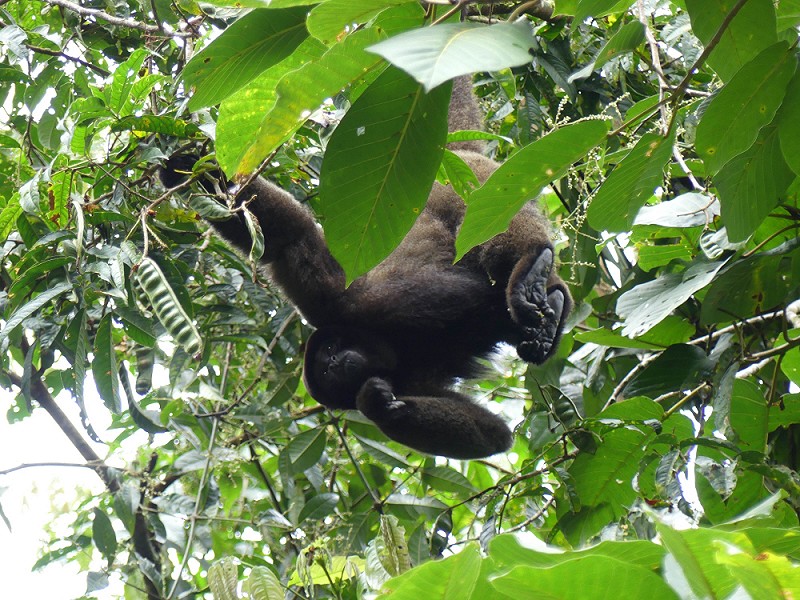 Brown Woolly Monkey Lagothrix lagotricha (Arjan Dwarshuis)
Brown Woolly Monkey Lagothrix lagotricha (Arjan Dwarshuis)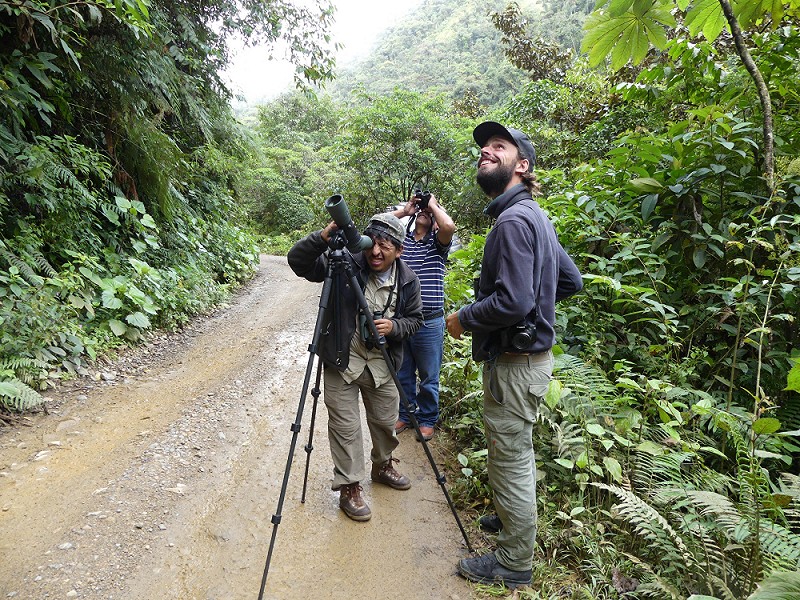 Birding the Manu Road (Camilla Dreef)
Birding the Manu Road (Camilla Dreef)
September 2nd THE MOST CRAZY DAY OF MY YEAR SO FAR
When your day starts with displaying Swallow-tailed Nightjars right over your head and you end that same day with a singing Lyre-tailed Nightjar perched in the scope, then you know it’s a mental day regardless. All the things we saw in between these two fantastic night birds will blow your mind… I can still hardly believe the complete mayhem of birdlife we encountered.
Ok, long story short I saw more than 70 (!) new birds for my Biggest Year, among them many rare and most wanted enigmas.
After the nightjar and breakfast – while looking down over continues cloud forest stretching down all the way to the Madre de Dios river, 2500 meters below us – we started roadside birding down the legendary Manu Road. Flocks were lurking around every corner. Every hundred meters or so we had to stop to scan through a bird-wave. Besides countless different tanager and hummingbird species we saw both Grey-breasted Mountain- and Blue-banded Toucanet, the range-restricted Fulvous Wren and the endemic Marcapata Spinetail.
Two undoubted highlights of the day came in relatively quick succession, a beautiful Chestnut-crested Cotinga perched next to the road and a pair of Solitary Eagles, displaying over the forested hillside thereby grabbing each other’s talons and tumbling down from the sky.
Further down as we left the elfin forest and entered the cloud forest we encountered a whole new set of birds. Incredibly beautiful and adequately named Versicoloured Barbets, gaudy Golden-headed Quetzals and a pair of the rare Crimson-bellied Woodpecker had to fight for attention with huge flocks of tanagers. And this went on and on throughout the day and before we knew it we had entered the home of the amazing Andean Cock-of-the-Rock. We visited a lek of this most iconic Andean bird. A show that simply blows your mind.
And I almost forgot about Andean Motmot, White-capped Dipper and a roosting Andean Potoo. Like I mentioned earlier this day was just off the chain. And yes we finished with a displaying Lyre-tailed Nightjar, as if it wasn’t good enough yet :).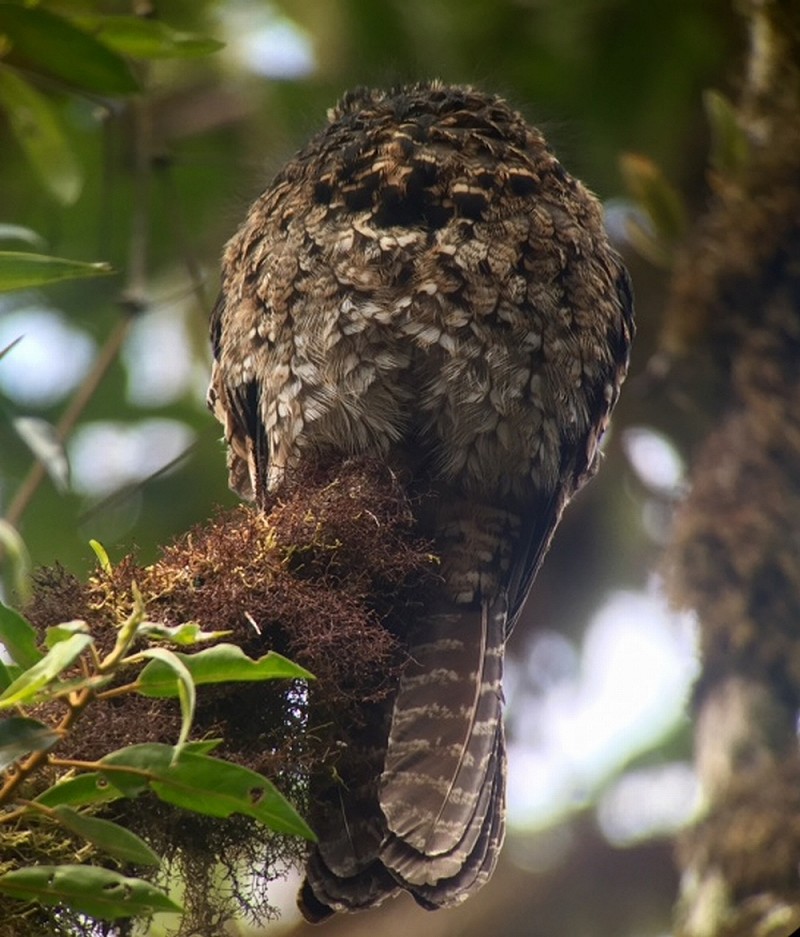 Andean Potoo Nyctibius maculosus (Arjan Dwarshuis)
Andean Potoo Nyctibius maculosus (Arjan Dwarshuis)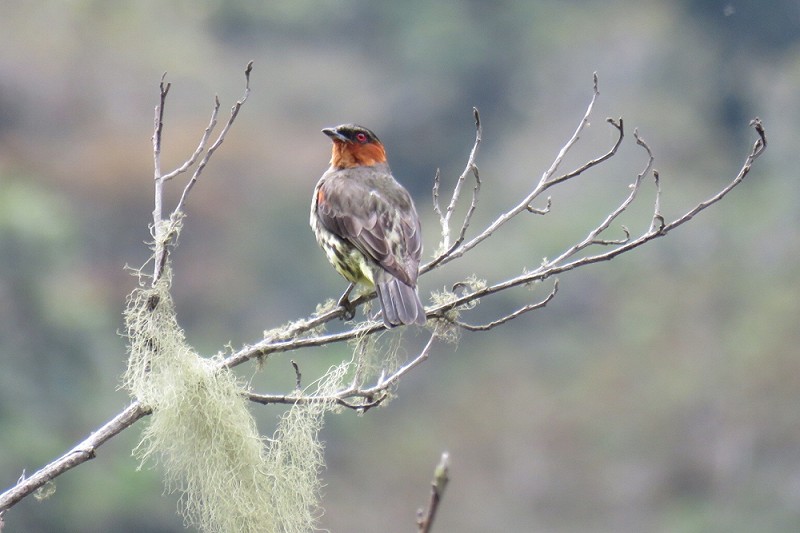 Chestnut-crested Cotinga Ampelion rufaxilla (Arjan Dwarshuis)
Chestnut-crested Cotinga Ampelion rufaxilla (Arjan Dwarshuis)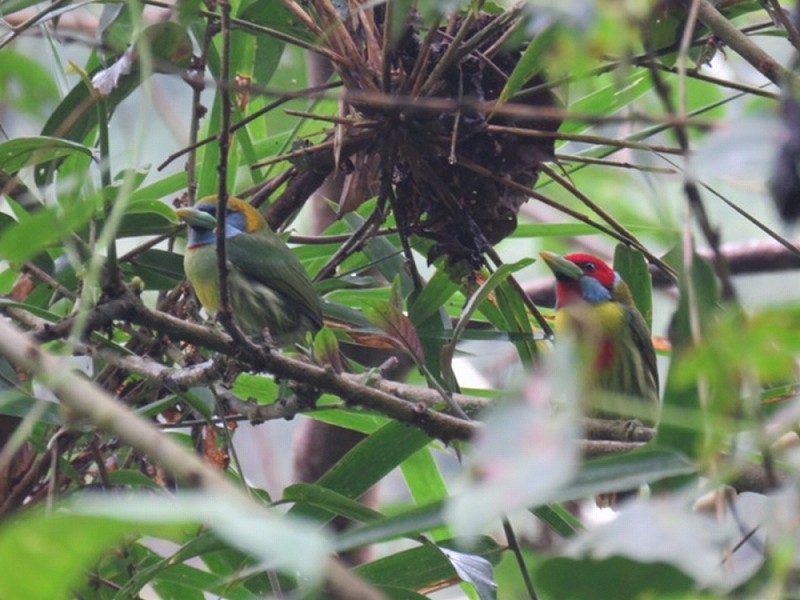 Versicoloured Barbet Eubucco versicolor (Arjan Dwarshuis)
Versicoloured Barbet Eubucco versicolor (Arjan Dwarshuis)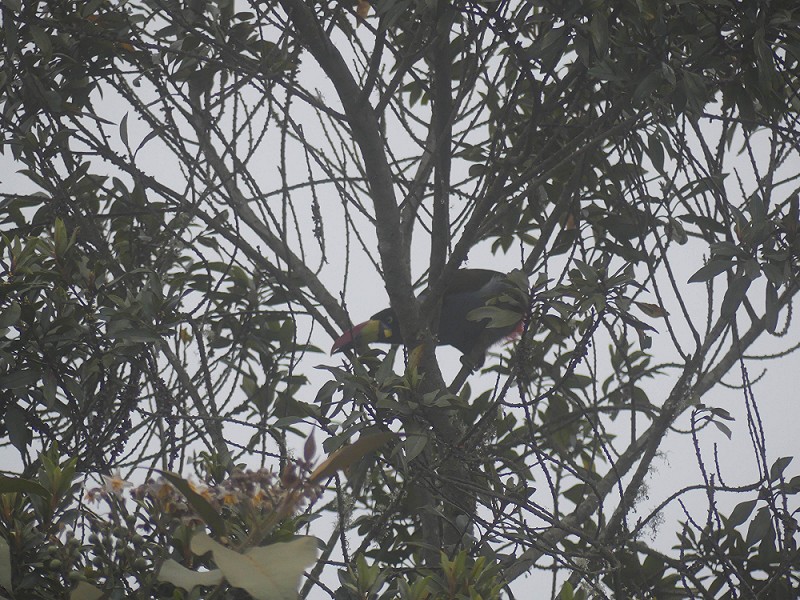 Grey-breasted Mountain-toucan Andigena hypoglauca (Arjan Dwarshuis)
Grey-breasted Mountain-toucan Andigena hypoglauca (Arjan Dwarshuis)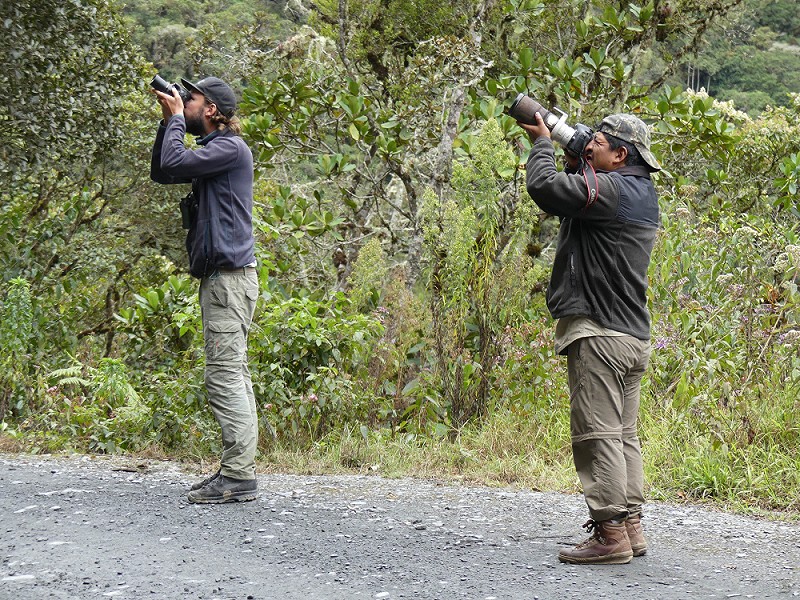 Birding the Manu Road (Camilla Dreef)
Birding the Manu Road (Camilla Dreef)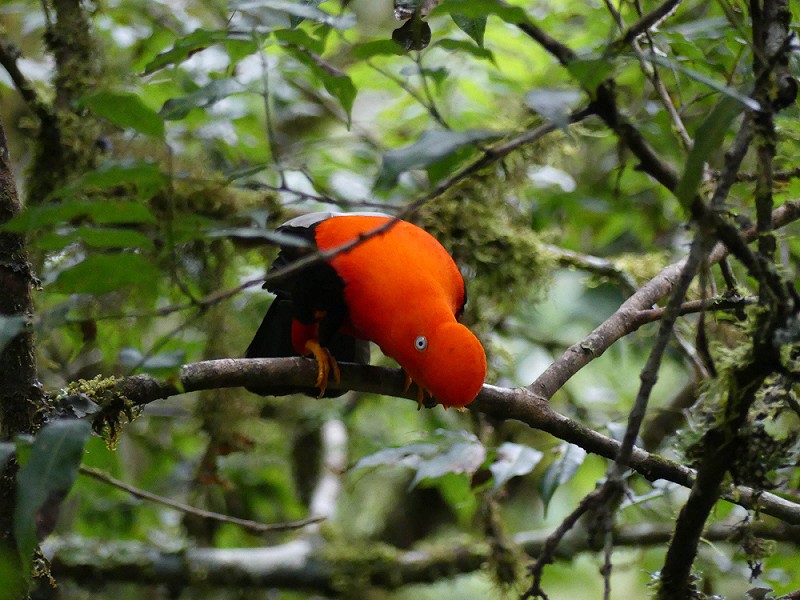 Andean Cock-of-the-rock Rupicola peruvianus (Camilla Dreef)
Andean Cock-of-the-rock Rupicola peruvianus (Camilla Dreef)
September 3rd THE BAMBOO FOREST OF VILLA CARMEN
Last evening we had arrived at Villa Carmen, a lodge and biological station initiated by the same organization as Wayquecha Biological Station, the Amazon Conservation Association. At this amazing place they are experimenting with new forms of sustainable land use, in doing so they hope to offer an alternative to the ‘slash-and-burn’ agriculture that is responsible for so much deforestation. Like Wayquecha all the income from tourism goes directly to conservation, education and scholarships for biologists and ecologists.
While having breakfast at 5 AM Miguel came with fantastic news. Apparently there is some very good spiny bamboo forest to be found at Villa Carmen and all the bamboo specialists can be found here. Great! I had not expected to get any chance on finding this specialties this year and the only possible location would have been at least a day traveling back and forward from Puerto Maldonado. Naturally we decided on spending the entire morning tracking down these specialties.
Shortly after entering the excellent trail system we entered the bamboo forest and after several hours we had found White-lined Antbird, Dot-winged Antwren, Bamboo Antshrike, Bamboo Foliage-gleaner, Flammulated Bamboo-tyrant, Goeldi’s Antbird and best the beautiful White-cheeked Tody-tyrant and the iconic Manu Antbird.
Later in the morning things got even more interesting with excellent views of Amazonian Antpitta, Rufous-capped Nunlet and a stunning Rufous-breasted Piculet.
After a great lunch and an inspirational talk with Jeff Woodman - one of the board members of the Amazon Conservation Association - we hit the trails again, but around 4 it began to rain heavily so we had to aboard our afternoon birding session.
September 4th BACK UP THE MANU ROAD
Miguel had made an excellent plan of attack for the morning. We would make one more swoop through the bamboo forest to look for Striated Antbird and afterwards bird till 9 AM in the secondary forest to look for Fine-barred Piculet. After half an hour on the trail Miguel heard a Striated Antbird and we managed to get good looks at the bird. The piculet took some more time, but after some persuasion we found a pair of this near endemic. The most unexpected and most awesome sighting of the morning however, was a group of 4 Razor-billed Curassows walking in the middle of the trail!
After saying goodbye to all the staff at Villa Carmen – you guys were great and Camilla and I will certainly come back in the future – we travelled back up the Manu Road. At the bamboo forest at the lowest part of the Manu Road we made a stop to look for two endemics, the Black-backed Tody-flycatcher and Peruvian Piedtail which we both found quickly.
A little bit higher up – at the transition from sub-montane forest to cloud forest - we found several other specialties like Cinnamon-faced Tyrannulet, Golden-collared Honeycreeper, Grey-mantled Wren and a very showy Chestnut-tipped Toucanet. On one of Miguel’s secret stakeouts we found an unbelievably showy Slaty Gnateater and moments later we were treated to a calling male Crested Quetzal! Our best find however was a Black-streaked Puffbird, which Miguel brilliantly found on call!
From hereon we travelled all the way up to the treeline – picking up another Grey-breasted Mountain-toucan, a Yungas Pygmy-owl and a Golden-browed Chat-tyrant along the way – and from there all the way to Urubamba where we spend the night at Miguel’s parents’ place. So kind of them to let us crash and they’d even prepared dinner for us! Tomorrow we will chase Peruvian endemics around the famous Abra Malaga pass!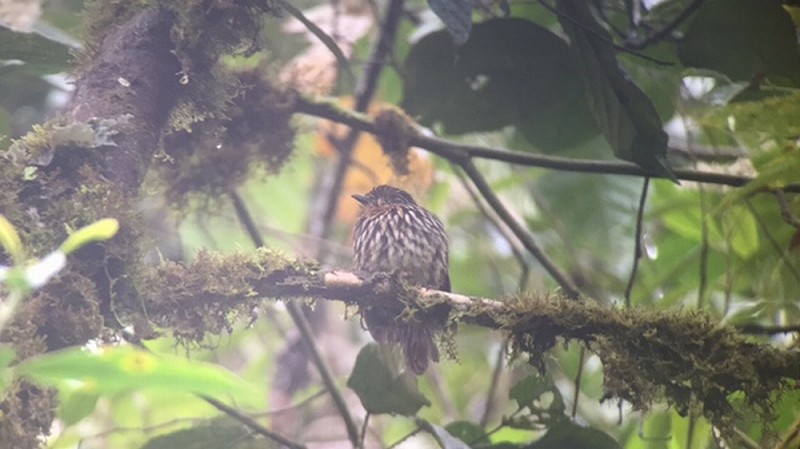 Black-streaked Puffbird Malacoptila fulvogularis (Arjan Dwarshuis)
Black-streaked Puffbird Malacoptila fulvogularis (Arjan Dwarshuis)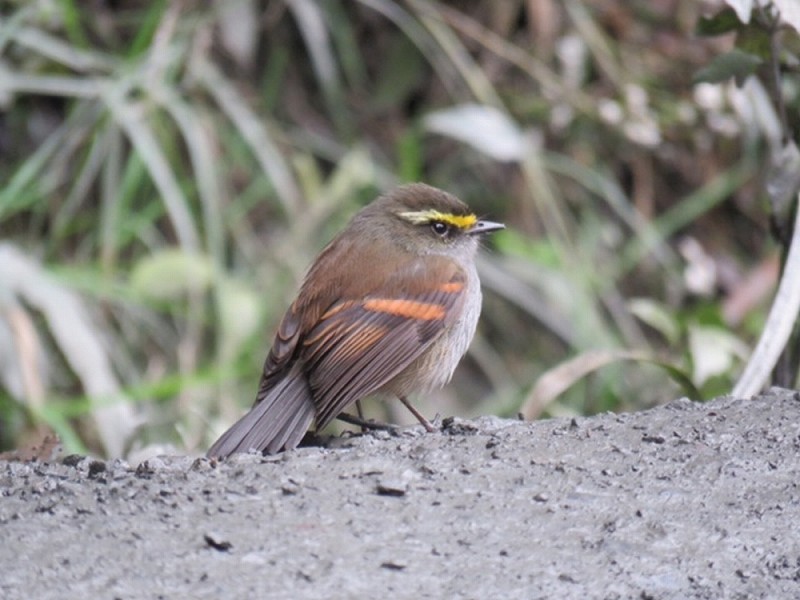 Golden-browed Chat-Tyrant Silvicultrix pulchella (Arjan Dwarshuis)
Golden-browed Chat-Tyrant Silvicultrix pulchella (Arjan Dwarshuis)
September 5th RARITIES OF ABRA MALAGA
Today we would search for one of the rarest and most sought after birds in Peru, the critically endangered Royal Cinclodes. This spectacular furnarid has suffered tremendously from logging of polylepis forest for use of firewood. Polylepis forest is a peculiar type of stunted forest that is only found above 4000 meters in the Andes. Besides the Royal Cinclodes it provides home for a very specialized bird community that includes several rare and endangered species.
Before we would visit the polylepis forest above Abra Malaga pass however, we would first have to track down a couple of endemics in the elfin forest on the east slope of the pass. En Route we picked up Puna Tapaculo and the endemic Junin Canastero in the dry scrub on the west side of the pass.
We were highly successful in the elfin forest and within 2 hours’ time we found all our targets: the endemic Inca Wren, Cuzco Brush-finch, Parodi’s Hemispingus, Tit-like Dacnis, Plushcap, Unstreaked Tit-tyrant, Diademed Tapaculo, Scaled Metaltail and the local form of Rufous Antpitta.
From here we drove up again to the pass and from there we went on foot, up the pass and down into the valley on the other side were the polylepis pockets are found. We would walk all the way down to the bottom of the valley where Juve would pick us up again. Besides the spectacular birds the scenery is truly breath-taking; in the literal sense of the word since the polylepis lies at 4300 meters!
We started off on the same pace as in the elfin forest with a small flock containing Ash-breasted Tit-tyrant, Giant Conebill, Tawny Tit-spinetail and the endangered White-browed Tit-spinetail. Meanwhile Stripe-headed Antpitta’s were calling from the valley below us. Red-rumped Bush-tyrant was also quickly located.
Now there was only the Royal Cinclodes… We waited for half an hour or so, now and then playing some sound. Suddenly there was a movement in the understoy of the polylepis and moments later we had brief, but smashing views of a Royal Cinclodes! Mission accomplished.
After teaming-up again with Juve down in the valley we drove down towards Mollepata. En route we picked up two endemic hummingbirds, the White-tufted Sunbeam and the Green-and-white Hummingbird, the latter with a backdrop of the spectacular Ollaytaytambo Inca ruins.
Just before dark we tried for the endemic Pale-tailed Canastero, but we got no response. Much more unexpected however was a calling Taczanowski’s Tinamou! We tried to get closer and got to within 20 meters of the bird, but then it stopped calling… damn…
Amazing days usually end with an amazing night bird and this day was no exception on that rule. A stunning pair of the little known Koepcke’s Screech-owl was the icing on the cake that night.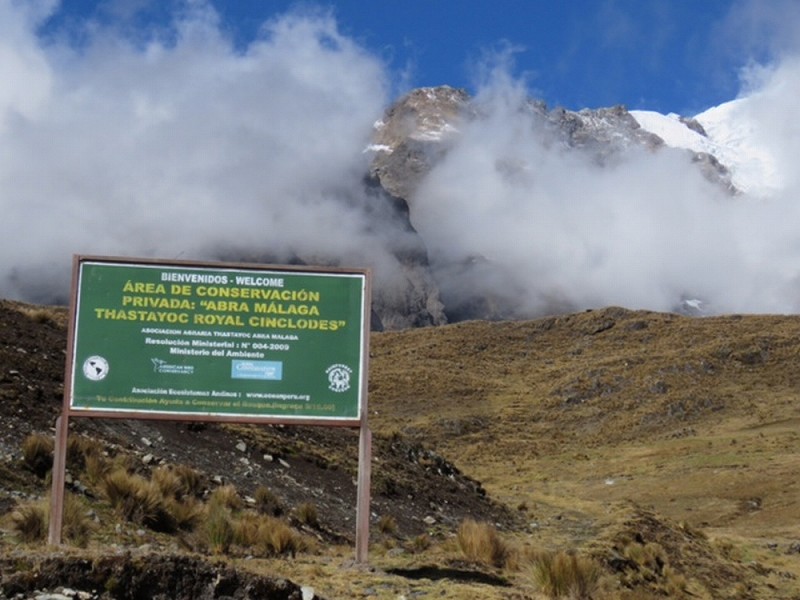 Abra Malaga (Arjan Dwarshuis)
Abra Malaga (Arjan Dwarshuis)
September 6th APURIMAC ENDEMICS
We had a long travel day ahead of us, from Mollepata we had to get all the way to the Andean town of Puquio, half way between Mollepata and Lima. First however we would look for some endemics of the Apurimac Valley above the town of Mollepata.
We started with the adequately named Apurimac Spinetail and Apurimac Brush-finch, both were quickly found while having breakfast at Miguel’s stakeout for these two species.
After breakfast we drove up to the treeline were we searched – with success – for the highly localized Vilcabamba Tapaculo.
Now it was time to commence with our long drive down into the inter-montane Apurimac valley and up again into the high Andes, but not before we found the rare ushueri race of the endemic Pale-tailed Canastero in its dry scrubby home.
There was one more surprise waiting for us… during a lunch stop at the top of the Apurimac valley Miguel played some sound of the yet-to-be-formerly-described ‘Apurimac’ Tapaculo and to our amazement one immediately gave a response! For half an hour we tried to get a view of the bird, but it proved extremely elusive, we had to settle with brief skulking views of this enigma. 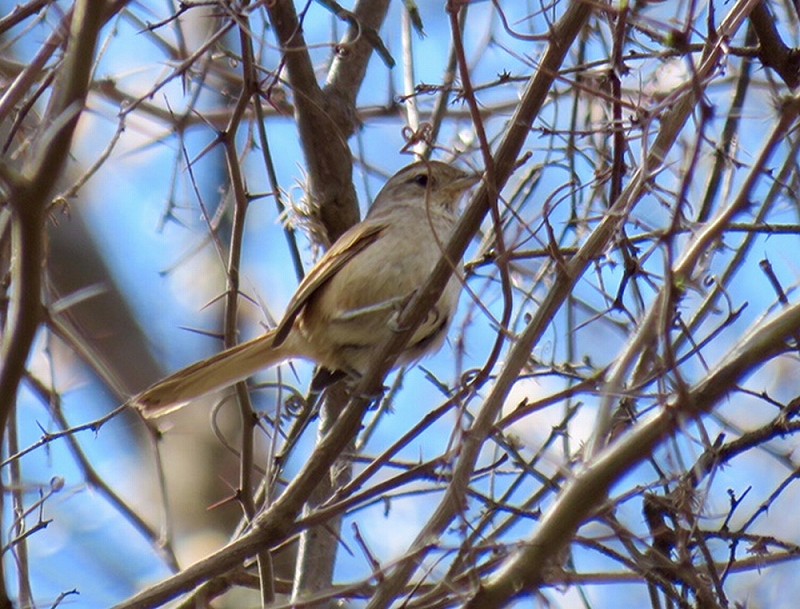 Pale-tailed Canastero Asthenes huancavelicae (Arjan Dwarshuis)
Pale-tailed Canastero Asthenes huancavelicae (Arjan Dwarshuis)
September 7th A HUGE SURPRISE EN ROUTE TO LIMA
We left Puquio at 4:30 AM since we had a 700 kilometre drive to Lima ahead of us – enormous respect for Juve for tackling such distances behind the wheel without even blinking.
Again we had a couple of planned stops en route. The first one was at a dry forested river bed below the city of Nasca – yes, we ‘twiched’ the famous Nasca lines from a small lookout tower along the highway :). Our target here was the vulnerable Slender-billed Finch which we found foraging alongside Parrot-billed- and Drab Seedeaters.
As we drove further through the Atacama Desert to the coast I suddenly spotted a couple of martins flying next to the road. We stopped and to our amazement we found out that they were Peruvian Martins, at least 20 birds! Luckily Miguel was able to take some pictures of these rare and poorly known birds as they migrated north through the desert. This is a significant record illustrating that these birds must have their wintering grounds somewhere further south in the desert - maybe the border region with Chile? Anyhow a huge bonus!
Our last stop was at the coastal fishing village of El Poqueron. Here we found the endemic Peruvian Seaside Cinclodes and several Humbolt Penguins and breeding Inca Terns and Red-legged Cormorants – resulting in a very happy Camilla!
We spent the night at Wim ten Have’s home 20 kilometres north of Lima. Tomorrow we will start with our swoop through the endemic-packed central part of Peru!
Arjan Dwarshuis
http://www.arjandwarshuis.com/#biggestyear
http://world.observation.org/arjan.php
PLEASE MAKE A DONATION NOW!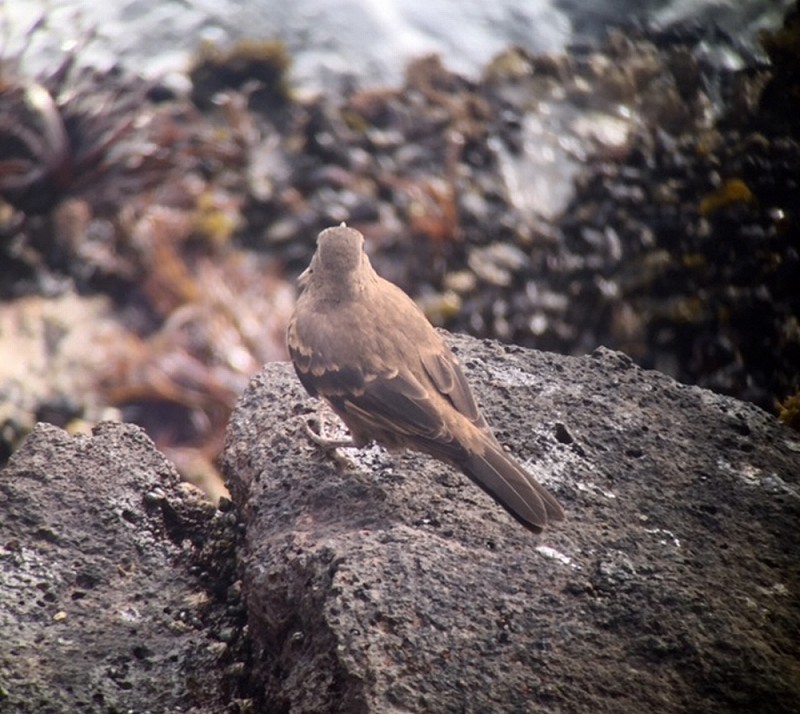 Peruvian Seaside Cinclodes Cinclodes taczanowskii (Arjan Dwarshuis)
Peruvian Seaside Cinclodes Cinclodes taczanowskii (Arjan Dwarshuis)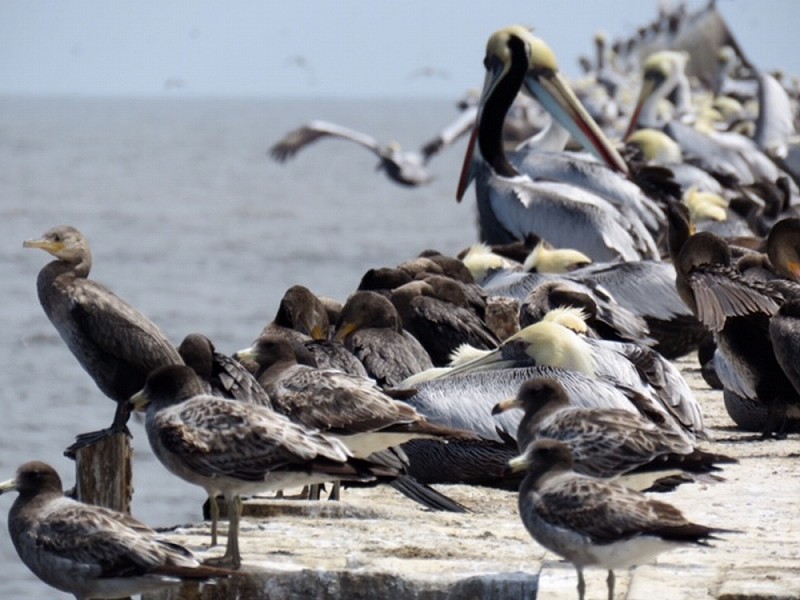 Peruvian pelican Pelecanus thagus (Arjan Dwarshuis)
Peruvian pelican Pelecanus thagus (Arjan Dwarshuis)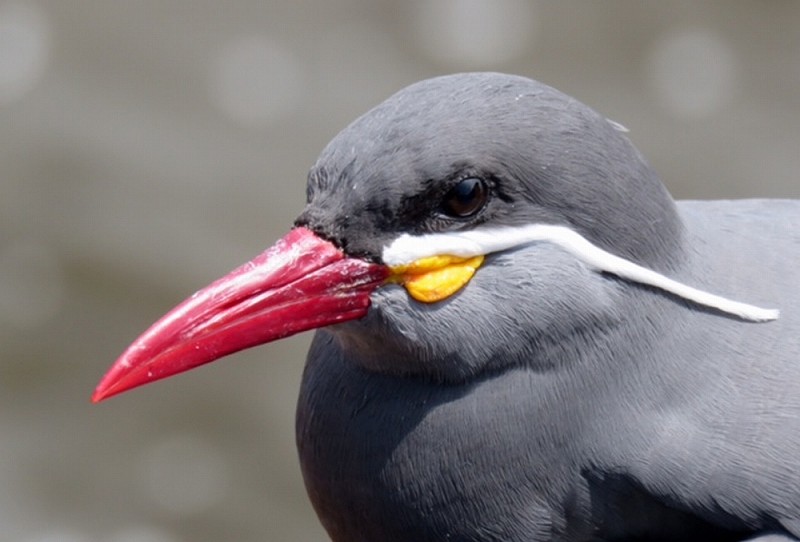 Inca Tern Larosterna inca (Arjan Dwarshuis)
Inca Tern Larosterna inca (Arjan Dwarshuis)
Discussie
Gebruikers van het forum gaan akkoord met de forumregels.



















